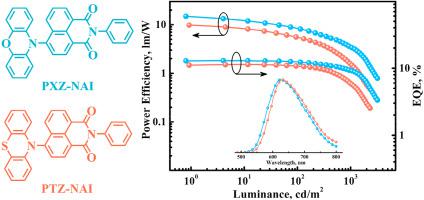Organic Electronics ( IF 2.7 ) Pub Date : 2020-11-04 , DOI: 10.1016/j.orgel.2020.106012 Binyan Wang , Yuanyuan Zheng , Tao Wang , Dongge Ma , Qiang Wang

|
The connection of an electron deficient 1,8-naphthalimide acceptor moiety with a phenoxazine or phenothiazine donor moiety afforded 6-(10H-phenoxazin-10-yl)-2-phenyl-1H-benzo[de]isoquinoline-1,3(2H)-dione (PXZ-NAI) and 6-(10H-phenothiazin-10-yl)-2-phenyl-1H-benzo[de]isoquinoline-1,3(2H)-dione (PTZ-NAI) as two novel red thermally activated delayed fluorescence (TADF) emitters. The two emitters exhibited distinct TADF characteristics with small energy gaps between the lowest singlet and triplet excited states, which originated from the well-separated highest occupied molecular orbital and lowest unoccupied molecular orbital distributions. The optimized TADF organic light-emitting diodes based on PXZ-NAI and PTZ-NAI offered maximum external quantum efficiencies (EQEs) of 13.0% and 11.4% with maximum power efficiencies of 14.8 and 9.8 lm/W, respectively. Both devices emitted red electroluminescence spectra with peaks at 624 and 632 nm, and Commission Internationale de L'Eclairage coordinates of (0.610, 0.388) and (0.630, 0.368), respectively. These findings demonstrate that the combination of 1,8-naphthalimide with phenoxazine or phenothiazine could be an effective pathway for developing red TADF emitters.
中文翻译:

基于1,8-萘二甲酰亚胺的杂化物,用于高效的红色热激活延迟荧光有机发光二极管
将缺电子的1,8-萘二甲酰亚胺受体部分与吩恶嗪或吩噻嗪供体部分连接,得到6-(10 H-吩恶嗪-10-基)-2-苯基-1 H-苯并[ de ]异喹啉-1,3 (2 H)-二酮(PXZ-NAI)和6-(10 H-吩噻嗪-10-基)-2-苯基-1 H-苯并[ de ]异喹啉-1,3(2 H)-二酮(PTZ-NAI)作为两个新型的红色热激活延迟荧光(TADF)发射体。这两个发射器显示出独特的TADF特性,在最低单重态和三重态激发态之间具有较小的能隙,这是由良好分离的最高占据分子轨道和最低未占据分子轨道分布引起的。基于PXZ-NAI和PTZ-NAI的经过优化的TADF有机发光二极管提供的最大外部量子效率(EQE)分别为13.0%和11.4%,最大功率效率分别为14.8和9.8 lm / W。两种器件均发出红色电致发光光谱,其峰值分别在624和632 nm处,国际照明委员会的坐标为(0.610,0.388)和(0.630,0.368)。这些发现表明,1的组合








































 京公网安备 11010802027423号
京公网安备 11010802027423号